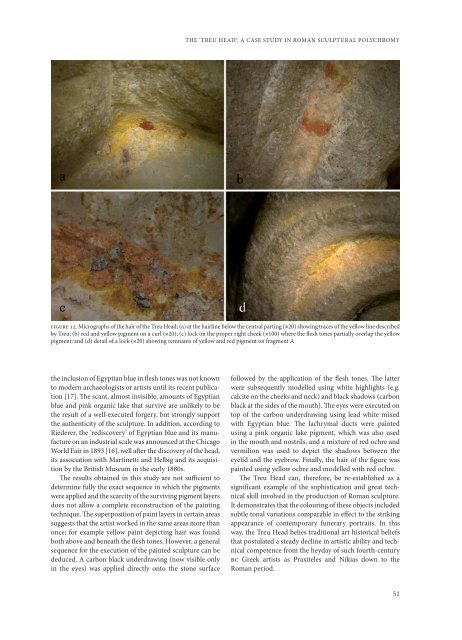You also want an ePaper? Increase the reach of your titles
YUMPU automatically turns print PDFs into web optimized ePapers that Google loves.
THE ‘TREU HEAD’: A CASE STUDY IN ROMAN SCULPTURAL POLYCHROMY<br />
figure 12. Micrographs of the hair of the Treu Head; (a) at the hairline below the central parting (�20) showing traces of the yellow line described<br />
by Treu; (b) red and yellow pigment on a curl (�20); (c) lock on the proper right cheek (�100) where the flesh tones partially overlap the yellow<br />
pigment; and (d) detail of a lock (�20) showing remnants of yellow and red pigment on fragment A<br />
the inclusion of Egyptian blue in flesh tones was not known<br />
to modern archaeologists or artists until its recent publication<br />
[17]. <strong>The</strong> scant, almost invisible, amounts of Egyptian<br />
blue and pink organic lake that survive are unlikely to be<br />
the result of a well-executed forgery, but strongly support<br />
the authenticity of the sculpture. In addition, according to<br />
Riederer, the ‘rediscovery’ of Egyptian blue and its manufacture<br />
on an industrial scale was announced at the Chicago<br />
World Fair in 1893 [16], well after the discovery of the head,<br />
its association with Martinetti and Helbig and its acquisition<br />
by the <strong>British</strong> <strong>Museum</strong> in the early 1880s.<br />
<strong>The</strong> results obtained in this study are not sufficient to<br />
determine fully the exact sequence in which the pigments<br />
were applied and the scarcity of the surviving pigment layers<br />
does not allow a complete reconstruction of the painting<br />
technique. <strong>The</strong> superposition of paint layers in certain areas<br />
suggests that the artist worked in the same areas more than<br />
once; for example yellow paint depicting hair was found<br />
both above and beneath the flesh tones. However, a general<br />
sequence for the execution of the painted sculpture can be<br />
deduced. A carbon black underdrawing (now visible only<br />
in the eyes) was applied directly onto the stone surface<br />
followed by the application of the flesh tones. <strong>The</strong> latter<br />
were subsequently modelled using white highlights (e.g.<br />
calcite on the cheeks and neck) and black shadows (carbon<br />
black at the sides of the mouth). <strong>The</strong> eyes were executed on<br />
top of the carbon underdrawing using lead white mixed<br />
with Egyptian blue. <strong>The</strong> lachrymal ducts were painted<br />
using a pink organic lake pigment, which was also used<br />
in the mouth and nostrils, and a mixture of red ochre and<br />
vermilion was used to depict the shadows between the<br />
eyelid and the eyebrow. Finally, the hair of the figure was<br />
painted using yellow ochre and modelled with red ochre.<br />
<strong>The</strong> Treu Head can, therefore, be re-established as a<br />
significant example of the sophistication and great technical<br />
skill involved in the production of Roman sculpture.<br />
It demonstrates that the colouring of these objects included<br />
subtle tonal variations comparable in effect to the striking<br />
appearance of contemporary funerary portraits. In this<br />
way, the Treu Head belies traditional art historical beliefs<br />
that postulated a steady decline in artistic ability and technical<br />
competence from the heyday of such fourth-century<br />
bc Greek artists as Praxiteles and Nikias down to the<br />
Roman period.<br />
51

















